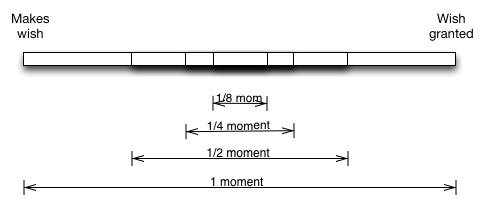- What is the significance of a set that is recursively
enumerable but not recursive?
A set that is recursively enumerable can be generated by a formal system. A set that is recursive is one that both (1) is recursively enumerable and (2) whose complement is recursively enumerable. So if a set is r.e. but not recursive, its elements (figure) can be mechanically generated, but its non-elements (ground) cannot be!
- Characterize the sequence of integers (from GEB)
1 3 7 12 18 26 35 45 56 69....
How are the notions of figure and ground intertwined here?
To quote from the On-Line Encyclopedia of Integer Sequences (Sequence A005228): "This is the lexicographically earliest sequence that together with its first differences contain every positive integer exactly once."
Weirdly, it is the "ground elements" (2 4 5 6 8 9 10 11 13 14 15 16 17 19 ....) tell you how to generate the sequence itself (the "figure" elements). Call the sequence F, and its ground G. Then:
F(0) = 1 G(0) = 2 F(n+1) = F(n) + G(n), where G is the sequence of elements not in F.
You cannot define the figure and the ground separately; they are intertwined.
- Give formal systems for
- (Non-negative) Binary numerals divisible by 4
- (Non-negative) Binary numerals not divisible by 4
Here is a formal system for non-negative binary numbers divisible by 4. I'm assuming the phrase "binary numerals" refers to the infinite set {0, 1, 10, 11, 100, 101, 110, ...}, that is, all binary numerals start with a 1 except for 0 itself.
Axiom 1: 0 is a theorem. Axiom 2: If x is a string of zero or more 0s and 1s, then 1x00 is a theorem.Here is the formal system for generating the complement (binary numerals not divisible by 4):
Axiom 1: 1 is a theorem. Axiom 2: 10 is a theorem. Axiom 3: 11 is a theorem. Axiom 4: If x is a string of zero or more 0s and 1s, then 1x01, 1x10, and 1x11 are theorems. - How is Hofstadter's Contracrostipunctus an acrostic?
How is it self-referential?
Contracrostipunctus is an acrostic because the first letters of each paragraph spell out a message, namely: "Hofstadter's Contracrostipunctus Acrostically Backwards Spells J.S. Bach". That phrase is actually self-descriptive: take that phrase acrostically backwards to see why! The dialog itself is self-referential: one of its characters muses about a dialog in which the author "write[s] a contrapuntal acrostic in homage to J. S. Bach ... and embedding his own name." In addition, the dialog's acrostic message contains its title.
- How did the Tortoise show, in Contracrostipunctus,
that there is no such thing as a "perfect record player"? How
is this related to Gödel's demonstration that there is
no "perfect" formal system for number theory?
The tortoise defined a "perfect record player" as one that could produce every possible sound, but showed that no such record player could exist since no player can play its own self-breaking sound. This is similar to Gödel's demonstration that it is possible to express, in all formalizations of number theory, a statement which asserts its own unprovability in the system. No perfect (in the sense of being both sound and complete) system of number theory can exist because it cannot prove a statement that asserts its own unprovability.
- What is meant by the statement that consistency is not an
inherent property of a formal system?
A formal system is never consistent or inconsistent on its own, but only relative to an interpretation. That is, a given formal system can be consistent under one interpretation but inconsistent under another.
- In Hofstadter's Little Harmonic Labyrinth, is GOD a djinn?
Why or why not?
No. GOD is the infinite collection of djinns. The collection of djinns is a collection, not a djinn.
- Why was Achilles able to get a meta-wish, despite having his
request for one passed sequentially through an infinite chain of genies?
The message took a finite amount of time to be relayed through the infinite chain of genies, because each meta-djinn took less time to process the wish than the djinn they were serving, leaving each "transaction" time for making a request and receiving the response. Pictorially:

Even though there are an infinite number of transactions, they all take place within a finite amount of time — one moment.
- Why did Achilles' wish ("I wish my wish would not be granted")
in Little Harmonic Labyrinth cause an indescribable event to
occur?
The wish could only be granted by not granting it, but to not grant it would be to grant it. The only way to handle this wish was to do something that cannot be described. We don't know exactly what happened (the event was indescribable, after all!) but it caused the system of djinns to crash.
- How does the discussion about "tonic" in Little Harmonic
Labyrinth relate to the dialog itself?
When explaining tonics, the Tortoise talks about musical modulations temporarily taking the listener into different keys, leaving the listener (if not too confused) with an expectation of returning to the original key to resolve the tension of having wandered into a different key. The dialog also "modulates", as it features several subdialogs into which the reader pushes and out of which the reader pops, always holding an expectation to see whether the Tortoise ends up getting eaten or not.